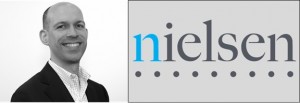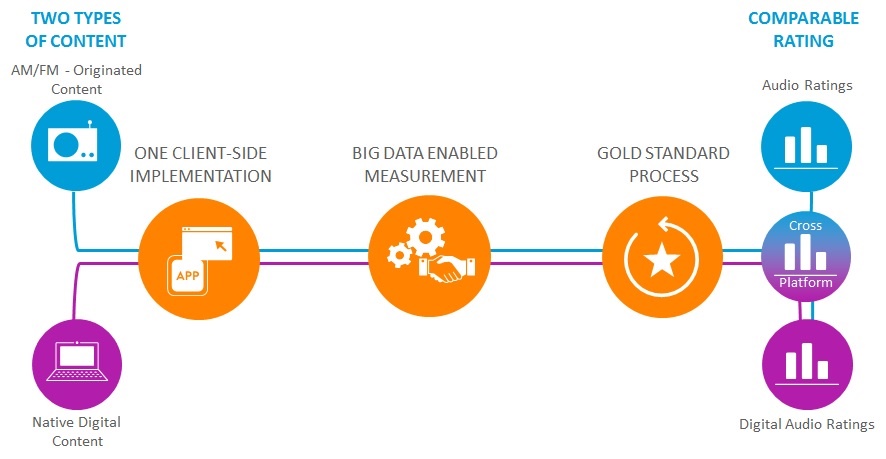This blog continues to be focused on the different ways in which audiences are consuming radio content. As station end users have gone beyond terrestrial listening on “regular radios” to streams via websites, apps, and podcasts, measurement of this usage has not kept pace.
The Nielsen SDK has been a big topic in radio circles because of anticipation of how streaming and digital usage by broadcast brands will be measured and marketed. For radio, this is a huge deal, yet many broadcasters only have a vague knowledge of this initiative.
Our mobile apps company, jācapps, is in the thick of this project. It was the first mobile company to have its platform certified for the Nielsen SDK. So far, jācapps has enabled dozens of stations for this new tracking system. To say the least, we’re all in.
Nielsen’s point man on the project is its VP/Digital Audio, Rob Kass. He’s the guy who oversees Nielsen’s strategy for Digital Audio measurement. Rob has a background in the radio business, having worked in small Midwest markets before joining Nielsen six years ago. Today in JacoBLOG’s “Guest List, Rob talks about the Nielsen SDK, and what the radio industry can expect in the coming months:
 Technology continues to alter the way audiences consume audio. Consumers can now listen to what they want, when they want and however they want. Breakthroughs like connected devices, digital in-car consoles, audio aggregator apps and podcast networks provide listeners with more choices and flexibility than ever before. These choices also bring with it audience fragmentation and marketplace challenges regarding how to best create, distribute and monetize audio content.
Technology continues to alter the way audiences consume audio. Consumers can now listen to what they want, when they want and however they want. Breakthroughs like connected devices, digital in-car consoles, audio aggregator apps and podcast networks provide listeners with more choices and flexibility than ever before. These choices also bring with it audience fragmentation and marketplace challenges regarding how to best create, distribute and monetize audio content.
Just as Nielsen has done with video measurement, we are evolving our audio measurement to provide clients with a more sophisticated way to understand audio consumption and engagement across devices and ad models.
Over the past year, Nielsen has worked with dozens of clients, vendors and audio aggregators to integrate our software development kit (SDK) into the audio ecosystem. Leveraging the same technology deployed with video, the SDK has enabled the measurement of more than 2,500 station streams in Nielsen’s 48 portable people meter (PPM) markets, following audio content across devices and ad models.
In order to help the industry better understand the technology behind this new form of audio measurement, here’s our “5 Things Every Radio Professional Should Know About Nielsen’s Digital Audio Software Development Kit (SDK)”:
1. Nielsen’s Digital Audio SDK is a major step towards Total Audience for Audio.
By moving to SDK measurement for digital audio, we will be able to capture the breadth required to measure mobile listening. Instead of relying on a panel to capture tuning, we use big data and a census-style measurement approach that matches demographic information in a privacy-safe way via data providers, such as Facebook. We calibrate this with Nielsen’s audio panels to understand the connection between online and broadcast content. This helps unlock measurement of digitally-native on-demand content, e-radio and digital audio pure-plays. And it gives us the ability to measure and report time-shifted listening beyond the first 24 hours.
2. The Digital Audio SDK gets you out of the kitchen and puts you at the table.
Imagine measuring meal consumption based solely on what you see in a restaurant’s kitchen. You’d know what orders were coming in and what food was going out, and very little else. Now imagine sitting at the table and watching someone eating their meal. Aside from being an awkward dinner guest, you’d have a much clearer picture of who that person is, what they are eating and how much time they spent eating their meal.
In many respects, it’s a similar situation with digital audio measurement. You can measure digital audio using server-side metrics (from the kitchen), or you could measure at the device (at the table) with an SDK. Nielsen’s SDK data, when combined with 3rd party data and calibrated against our panel, gets you reach, demographic, duration and location information. It’s an independent measurement designed to align with existing radio measurement.
3. The SDK approach enables measurement to follow different types of content across devices and ad models.
Digital streams of AM/FM broadcasts. An excerpt of a morning drive program. A two-hour podcast available only online. A listener-curated digital stream. All of these and more can be measured by the SDK. And since we’re leveraging the same technology used in other Nielsen services, we’re able to provide consistent measurement across audio, video and text. For those who provide content in more than one medium, you’ll eventually have a comprehensive view of your audience across platforms.
4. SDK measurement is a team sport.
The SDK is implemented client-side and requires the cooperation of clients, vendors and other industry stakeholders. There will always be new devices and platforms coming onto the market and Nielsen will work vigorously with the industry to get the SDK integrated deeper into the audio ecosystem. We believe that the extra effort is worth it, given the high quality and robust metrics that SDK measurement provides.
5. Nielsen’s SDK technology will continue to evolve and adapt with the industry.
The list of top vendors, platforms and audio aggregators integrated with Nielsen’s SDK continues to grow. Nielsen is constantly monitoring consumer behavior to understand which new platforms and devices are gaining adoption. For example, now that the Android Auto and Apple CarPlay platforms are growing in popularity, we’ve made sure that our SDK supports apps distributed through those platforms.
Additionally, Nielsen is currently testing a cloud-based approach to SDK integration. This cloud technology will allow us to onboard new devices, dispatch fixes and enhancements in a more efficient manner and provide a lighter browser and app footprint.
In many ways, Radio leads when it comes to providing its content digitally and the industry is ready for independent, currency class measurement of the Total Audience. Nielsen is ready now and will be there to help the industry navigate that exciting future.
Thanks to Seth Resler for putting this Guest List post together. Rob Kass can be reached here.
More Guest Lists
- Jim Cutler: 5 Tips To Help Radio Turn Empty Imaging into Solid Content
- Blubrry’s Todd Cochrane: 5 Things You Should Know About Podcast Measurement
- A View Of A.I. Through The Radio Lens
- Chris Peterson: 5 Podcasting Predictions
- Alan Cross: 5 Music Facts That Will Stun You
- Can Radio Afford To Miss The Short Videos Boat? - April 22, 2025
- Media And Technology In 2025: Believe It Or Not! - April 18, 2025
- In Radio, You Just Never Know - April 17, 2025






Thank you for the great post Seth, Fred and Rob.
My question is, and I believe I have heard Seth ask this very one too, how will Nielsen get Apple, Pandora, and soon Google to play along? What about the podcast focused companies like BluBrry, Midroll and Libsyn? Each has developed their own audience measurement tech and won’t willingly abandoned it and pay money to Nielsen to use SDK.
We all believe there needs to be uniform measurement for digital audio but is that even possible in today’s world? I think we will have a multitude of tech to measure listening and viewership but in the end the most important thing will be how the metrics are defined so there is a relevant apple to apples comparison.
Sean, thanks for the comment. I have asked Rob to respond to your questions. Thanks as always for reading our blog.
Thanks Fred, I look forward to hearing what Rob has to say.
Thanks Sean. Nielsen’s goal, and what the industry has asked for, is to bring truly independent, third party measurement to the audio industry. SDK measurement requires participation from clients and vendors and Nielsen is committed to continuing a productive dialogue with the industry on expanding SDK integration deeper into the ecosystem. We’ve made tremendous progress in the past 8 months and expect to make similar progress as we move beyond our initial focus (providing metrics for the digital stations streams) and into measuring on-demand, including podcasting.
Thank you for the response Rob, I appreciate your contribution to the conversation. A measurement system for all audio would certainly be welcome. Can you expand some on the 8 months of progress you mentioned? Is that in reference to the technology, partners who have agreed to adopt the tech or both?
Thanks again.
FWIW – Midroll does not have their own system. They take measurements largely the big three podcast stats providers..
Blubrry, Libsyn and Podtrac which measure about 97% of the total podcasting space.
Blubrry which I am CEO, is a member of the IAB, Podcast Measurement committee, and will continue to work with the IAB on measurement standards.
It is well known Apple will never open up its data sets. The three companies below have had the tools needed to measure podcasts for over 10 years/
Thank you for clarifying about Midroll I was thinking of PodcastOne but mistakenly typed Midroll.
It is exciting to see the conversation about measurement standards, and in particular podcast measurement, in the news so much lately.
I look forward to seeing what fruit it bears.
Todd, thanks for helping inform the conversation. We appreciate you taking the time and reading our blog.
I was gonna say…the phrase “apples to apples” is pretty ironic in this circumstance. More like “apples to everyone else but Apple.” I’m sure there’s a blueberry joke in there somewhere too, but it’s early.